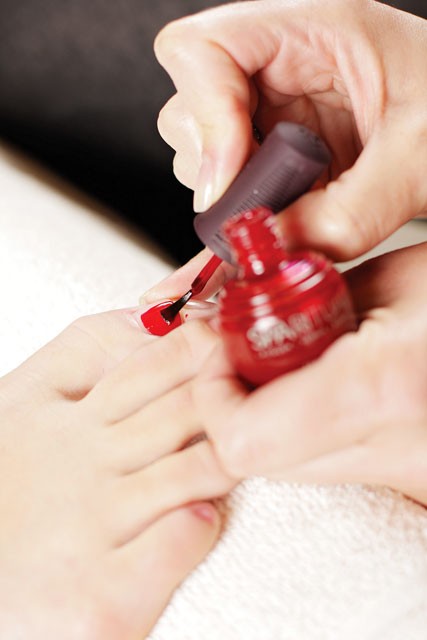Doug Schoon has seen the good, the bad and the ugly of the beauty industry. He is the founder of Schoon Scientific, which provides technological and regulatory expertise to the beauty, cosmetic and personal care industry. He’s also a chemist, author and educator with more than 30 years of experience in the cosmetology world. But his fundamental creed for manicure bargain hunters is also common sense: You get what you pay for.
Which is why consumers might exercise discernment when it comes to flashing neon signs advertising, say, full acrylic sets, dirt-cheap.
It’s possible salons touting services at rock-bottom prices may be using sub-par products containing low-quality ingredients — namely a substance called methyl methacrylate monomer, which was banned for use in nail enhancement by the FDA in the ’70s.
“It’s not a professional product,” says Schoon. “It’s designed to be cheap. That’s why it’s used — and that’s why it should not be used.”
What really gets under Schoon’s skin are the common misconceptions that MMA monomer causes cancer, birth defects or is highly toxic. Doctors use it internationally, he says, and it’s considered the best and most widely used bone cement in the world.
It’s just crappy for your hands.
“MMA monomer just shouldn’t be used [in salons],” Schoon says. “But the reason isn’t because it’s toxic. It just doesn’t make a good artificial nail.”
The stuff doesn’t adhere well to the natural nail unless the plate is aggressively abraded or roughed up (a process Schoon compares to pouring glue on a shag carpet, as opposed to hardwood floors).
“A cheater way is to rough up the nail, whereas the nail should be cleansed and the acrylic applied carefully and correctly,” he says. “It takes skill, knowledge and time. Nail technicians who don’t have those things will just rough up the nail and put it on.”
Stacy Baechler, nail technician at Current Spa & Salon in Northern Quest Resort & Casino, says filing should never be so harsh as to create nail trauma — “rings of fire,” as she calls it.
“Some of the cheaper places create a ring because they press down too far,” she explains. “Our acrylic is a lot different than what the cheaper places use.”
Kristine Shimmin, a Glen Dow Academy nail instructor, echoes what Schoon preaches: Price does correlate with quality.
“You can’t expect to get a good, quality product used on your hands — and done safely — unless you pay a reasonable price,” she says.
On the subject of “quickie” salons, Schoon says, three general safety and health hazards include lack of proper sanitation, skin contact with products that should be kept off the skin and failure to use proper ventilation.
Shimmin says red flags include heavy odors (there should actually be close to no odor at all), visible debris or dust in the workstations, use of products in unlabeled bottles or a number of technicians wearing masks (for additional indicators, see sidebar).
Sprout Salon & Spa on Francis Avenue carries an all-natural durable polish from the Zoya nail care line. It has next to no scent, according to hairstylist and nail artist Katasha Kubas, “so it’s great for people with sensitive allergies.”
“It’s also nice not having to worry about wearing masks,” she says, “as well as working in a salon where everything is natural and ‘go-green.’ Even the toe separators are biodegradable and eco-friendly.”
Sprout also lets clients keep disposable clip files, so the query of “Whose foot has this touched?” needn’t nag your conscience.
Another nuance in nail care is the availability of vegan products such as SpaRituals nail lacquer, used at places like Spa Paradiso, or Grassroots Wellness Spa on the South Hill. It’s kind of neat, especially if you’re not thrilled with the idea of bug byproducts on your hands.
“A lot of products that are really shiny or have a shimmer — they use ground-up beetles to create that look,” explains Paradiso nail tech Ali Adamson.
For acrylic durability without filing trauma, Shimmin says gel nails are a viable alternative. They’re applied thinner, cured with a UV light, have no odor and seem to cause less damage to the natural nail when removed.
In short, with nail services, you may get what you pay for. “Salons that crank people in and out like a factory don’t have time to properly clean and disinfect,” Schoon says. “If you go to those kinds of salons, you can expect to have more problems.”
SAFETY SAVVY SALONS
Salons should keep a logbook, or at least be able to tell you, when and how often foot spas are cleaned and disinfected.
Nail technicians should wash your hands or feet — and their own hands — before performing manicures or pedicures.
Current licenses should always be on display.
Technicians should never stick their fingers directly into jars or containers.
It’s against federal law for a nail technician to remove calluses or warts: they’re only allowed to smooth down calluses.
Nail technicians are at risk for developing allergies when exposed to dust and chemicals for extended periods of time. Well-ventilated workstations and buildings are key indicators of environment quality.
Source: “What to Look Out for in a Nail Salon” Consumer Guidelines, by the International Nail Technicians Association and Nail Manufacturers Council
















